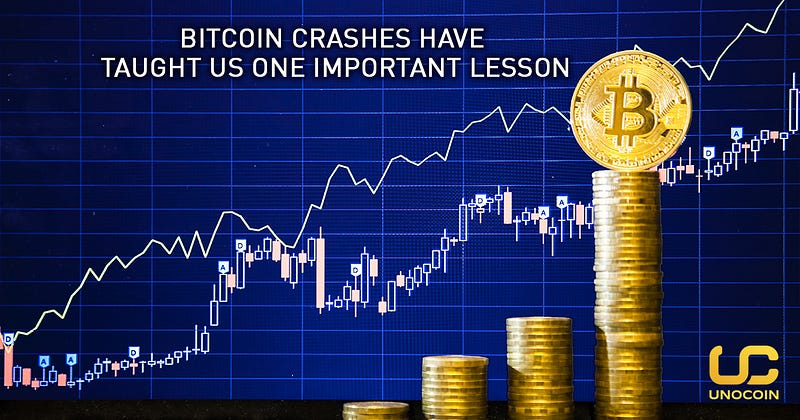
As a decentralised, peer to peer cryptocurrency free from external control, bitcoin has performed incredibly well, outdoing all other currencies and commodities by an unbelievably huge margin. But this very aspect of bitcoin that makes it so enticing as an alternative is also its bane. As a currency free from regulatory controls and in the absence of a central authority to stabilise the currency, bitcoin is uniquely sensitive to market changes. Proving that its fundamentals are sound, bitcoin has fallen only to rise to much greater heights. Here’s a short chronicle of the major jolts in the history of bitcoin and how bitcoin has rebounded every time.
2011: Mt. Gox hack
In June 2011, Mt Gox, the number one bitcoin exchange was hacked and the asking price was changed to 1 cent by the hackers, who bought bitcoin at the nominal amount. This caused a loss of over $850,000 to the exchange and prices dropped from a peak price of $32 to less than $2 over six months. Bitcoin ended the year at $4.50.
2012: Modest gains and a crash
Following the dismal performance and the slump in 2011, bitcoin rallied, albeit with fluctuations, to just over $15 when disaster struck again. This time it was a Ponzi scheme that left investors in the lurch, with a ludicrous promise of 1% daily profits on bitcoin investments. The Ponzi scheme operator made off with an estimated 500000 coins. Bitcoin sunk to the $10 mark and never crossed $15 again until the end of the year.
2013: Revival of hope in spring
It was in the first half of 2013 that bitcoin came into its own. Following mainstream media interest and coverage, bitcoin shot up to a spectacular $266, gladdening the hearts of early investors. Bitcoin started shedding its reputation for association with shady elements like drug dealers and started becoming a truly mainstream investment asset. The resulting hype created a bubble and bitcoin again shed a massive 71% of its value overnight, dropping to $67 from $233. An outage at Mt. Gox bitcoin exchange due to unprecedented traffic also made matters worse.

Spectacular rise and a stunning fall
In the latter half of 2013, bitcoin hovered around the $120 mark until November when it rose steeply to $1150 only to fall again to $500 by mid-December. This classic bubble was fuelled by speculating amateur investors who thronged to buy bitcoin following positive media coverage, increasing awareness, a positive stance adopted by regulatory authorities and the finding that bitcoin had shed its shady tag following greater adoption by law-abiding people. The crash was also made worse by the closure of Tradehill, a major bitcoin exchange second only to Mt. Gox.
Though bitcoin lost more than half of its peak value, putting aside short-term volatility, a general upward trend could be made out by the end of 2013.
2014: Mt. Gox goes bankrupt
In 2014, prices started picking up again through January until Mt. Gox was hacked the next month. On February 7, the leading bitcoin exchange halted withdrawals and made public that hackers had made off with 850,000 bitcoins (now worth around $4 billion). This severely undermined investor confidence and created an existential crisis of sorts for bitcoin. Many observers portended doom for bitcoin. Bitcoin’s value plummeted by over 49% and it never crossed the $1000 mark again for two long years.
2017: Adoption by Institutional investors
After a lackluster performance for two years from 2014, bitcoin breached the $1000 mark again due to renewed interest from the public, after knowledge of cryptocurrencies became mainstream. People learned that the fundamentals were sound and that cryptocurrencies were a much better alternative to fiat money. But, more than the public interest, it was institutional investors embracing bitcoin with open arms that powered bitcoin’s soaring rise to $5000 by the start of September.
Again, this didn’t last long as the shocked bitcoin community learned about China banning cryptocurrency exchanges with rumours doing the rounds that cryptocurrencies might be outlawed. China produces two out of every three bitcoins mined and is the mining capital of the world. Prices plunged by 37%. Further, JP Morgan called bitcoin a fraud, only to be caught buying huge quantities later at a lower price. These events brought down the price to $3200. But in less than a month, as of writing this article, bitcoin has again rebounded to over $4300.
Since institutional investors are heavily investing in bitcoin, it’s widely expected that bitcoin prices would only rise and reach $5000-$6000 in the coming days. Some are still skeptical and believe this is a bubble waiting to burst again.
Whatever might be the case, despite short-term volatilities, the upward trend has been fairly consistent. Bitcoin has fallen every time only to rise up to new highs. With the mainstream adoption and increasing acceptance of bitcoin as payment, the volatility is only expected to come down significantly. So, if you are looking to start on bitcoin with your eyes set on the long-term rewards, and if past trends are anything to go by, this bet may seem attractive.

Also Read:
https://blog.unocoin.com/bitcoin-vs-real-estate-80c486371ca5



